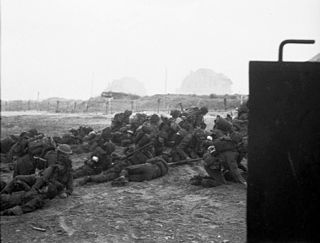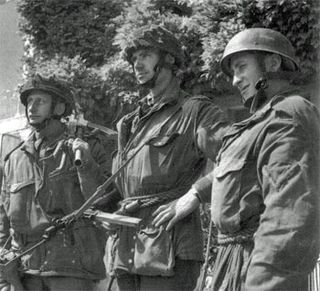
Sword, commonly known as Sword Beach, was the code name given to one of the five main landing areas along the Normandy coast during the initial assault phase, Operation Neptune, of Operation Overlord. The Allied invasion of German-occupied France commenced on 6 June 1944. Stretching 8 kilometres (5.0 mi) from Ouistreham to Saint-Aubin-sur-Mer, the beach proved to be the easternmost landing site of the invasion after the abortion of an attack on a sixth beach, code-named Band. Taking Sword was to be the responsibility of the British Army with sea transport, mine sweeping and a naval bombardment force provided by the British Royal Navy as well as elements from the Polish, Norwegian and other Allied navies.

The 2nd Canadian Division, an infantry division of the Canadian Army, was mobilized for war service on 1 September 1939 at the outset of World War II. Adopting the designation of the 2nd Canadian Division, it was initially composed of volunteers within brigades established along regional lines, though a halt in recruitment in the early months of the war caused a delay in the formation of brigade and divisional headquarters. With questions concerning overseas deployment resolved, the division's respective commands were formed in May and June 1940, and at British Prime Minister Winston Churchill's request, the division was deployed to the United Kingdom between 1 August and 25 December 1940, forming part of the Canadian Corps.

During the Second World War, the Royal Netherlands Motorized Infantry Brigade, later known as the Princess Irene Brigade was a Dutch military unit initially formed from approximately 1,500 troops, including a small group guarding German prisoners-of-war, who arrived in the United Kingdom in May 1940 following the collapse of the Netherlands. Elements of this force became the nucleus of what was originally called the "Dutch Legion."

The Guards Armoured Division was an armoured division of the British Army during the Second World War. The division was created in the United Kingdom on 17 June 1941 during the Second World War from elements of the Guards units, the Grenadier Guards, Coldstream Guards, Scots Guards, Irish Guards, Welsh Guards, and the Household Cavalry.

Gold, commonly known as Gold Beach, was the code name for one of the five areas of the Allied invasion of German-occupied France in the Normandy landings on 6 June 1944, during the Second World War. Gold, the central of the five areas, was located between Port-en-Bessin on the west and the Lieu-dit La Rivière in Ver-sur-Mer on the east. High cliffs at the western end of the zone meant that the landings took place on the flat section between Le Hamel and La Rivière, in the sectors code-named Jig and King. Taking Gold was to be the responsibility of the British Army, with sea transport, mine sweeping, and a naval bombardment force provided by the Royal Navy as well as elements from the Dutch, Polish and other Allied navies.

The 3rd Canadian Division is a formation of the Canadian Army responsible for the command and mobilization of all army units in the provinces of Manitoba, Saskatchewan, Alberta and British Columbia, as well as all units extending westwards from the city of Thunder Bay.

The 11th Armoured Division was an armoured division of the British Army which was created in March 1941 during the Second World War. The division was formed in response to the unanticipated success of the German panzer divisions. The 11th Armoured was responsible for several major victories in the Battle of Normandy from in the summer of 1944, shortly after the Normandy landings, and it participated in the Allied advance from Paris to the Rhine, the Rhine crossing in March 1945. It was disbanded in January 1946 and reformed towards the end of 1950. In 1956, it was converted into the 4th Infantry Division.

Operation Spring was an offensive operation of the Second World War conducted by II Canadian Corps during the Normandy campaign in 1944. The plan was intended to create pressure on the German forces operating on the British and Canadian front simultaneous with Operation Cobra, an American offensive. Operation Spring was intended to capture Verrières Ridge and the villages on the south slope of the ridge. The German defence of the ridge contained the offensive on the first day and inflicted many casualties on the Canadians.

The Côte Fleurie stretches for approximately 40 km (25 mi) between Merville-Franceville-Plage, at the mouth of the Orne river, opposite Ouistreham to the west and Honfleur on the Seine estuary in the east. It forms part of the eastern Basse-Normandie coast on the English Channel to the north of the Pays d'Auge in the Calvados department. The coast between the towns of Trouville and Honfleur, although part of the Côte Fleurie, is named Côte de Grace. Dives-sur-Mer is on the Côte Fleurie but possesses no beach or seafront. The Côte de Nacre continues west from the Touques estuary.

The Free Belgian forces were soldiers from Belgium and its colonies who fought as part of the Allied armies during World War II, after the official Belgian surrender to Nazi Germany. It is distinct from the Belgian Resistance which existed in German-occupied Belgium.

II Canadian Corps was a corps-level formation that, along with I (British) Corps and I Canadian Corps, comprised the First Canadian Army in Northwest Europe during World War II.
The 159th Infantry Brigade was an infantry brigade of the British Army. Part of the Territorial Army (TA), the brigade was assigned to the 53rd (Welsh) Infantry Division and served with the division in the early stages of the Second World War until May 1942 when it was transferred to be the motorised infantry element of the 11th Armoured Division. The brigade would serve with the 11th Armoured in North-west Europe from June 1944 to May 1945.

The 6th Airlanding Brigade was an airborne infantry brigade of the British Army during the Second World War. Created during May 1943, the brigade was composed of three glider infantry battalions and supporting units, and was assigned to the 6th Airborne Division, alongside the 3rd and 5th Parachute Brigades.
The 185th Infantry Brigade was an infantry brigade formation of the British Army raised during the Second World War that participated in the Normandy landings of 6 June 1944, fighting in the Normandy Campaign and the subsequent campaign in North-West Europe with the 3rd British Infantry Division.

Lieutenant General Jean-Baptiste Piron was a Belgian military officer, best known for his role in the Free Belgian forces during World War II as commander of the 1st Belgian Infantry Brigade, widely known as the "Piron Brigade", between 1942 and 1944.

The 6th Airborne Division advance to the River Seine occurred in August 1944, in the later stages of the Battle of Normandy, following the German Army's defeat in the Falaise Pocket, during the Second World War.

The First Canadian Army was a field army and a formation of the Canadian Army in World War II in which most Canadian elements serving in North-West Europe were assigned. It served on the Western Front from July 1944 until May 1945.

This is the Juno Beach order of battle on D-Day.

The term fusilier battalions denotes 57 separate military formations which were raised in Belgium to fight alongside the Western Allies in the final months of World War II. Unlike the Free Belgian Forces which were raised in exile, the fusilier battalions were raised within Belgium after its Liberation from German occupation in September 1944. In total, 57 battalions with a total of 53,700 men were raised between October 1944 and June 1945.

Liberation Route Europe is an international remembrance trail that connects the main regions along the advance of the Western Allied Forces toward the liberation of Europe and final stage of the Second World War. The route started in 2008 as a Dutch regional initiative in the Arnhem-Nijmegen area and then developed into a transnational route that was officially inaugurated in Arromanches on June 6, 2014, during the Normandy D-day commemorations. The route goes from Southern England through France, Belgium, Luxembourg, the Netherlands to Berlin in Germany, then extends to the Czech Republic and Poland. The southern route starts in Italy. As a form of remembrance tourism, LRE aims to unfold these Allied offensives of 1944 and 1945 in one narrative combining the different perspectives and points of view. By combining locations with personal stories of people who fought and suffered there, it gives visitors the opportunity to follow the Allied march and visit significant sites from war cemeteries to museums and monuments but also events and commemorations. In April 2019, Liberation Route Europe became a certified Cultural Route of the Council of Europe.























